 Website:
RIGEL Medical
Website:
RIGEL Medical
Group: Seaward Group
Catalog excerpts

An Introduction to Infusion Pump Testing Passionate about patient safety.
Open the catalog to page 1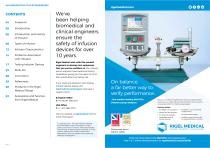
Introduction and History of Infusion Infusion Characteristics Problems Associated with Infusion Testing Infusion Devices Products in the Rigel Medical Range Accessories and Services from Rigel Medical We’ve been helping biomedical and clinical engineers ensure the safety of infusion devices for over 10 years. Rigel Medical work with like-minded engineers to develop test equipment that you can be confident in. Our infusion pump analyzers have expansive testing capabilities, giving you the peace of mind that specifications are being met. If you need any assistance with testing infusion...
Open the catalog to page 2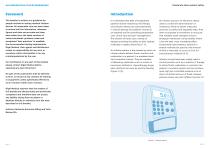
Passionate about patient safety. This booklet is written as a guideline for people involved in testing medical infusion devices. All reasonable care has been taken to ensure that the information, reference figures and data are accurate and have been taken from the latest versions of various standards, guidance notes and recognised “best practices” to establish the recommended testing requirements. Rigel Medical, their agents and distributors, accept no responsibility for any error or omissions within this booklet or for any misinterpretations by the user. It is estimated that 80% of...
Open the catalog to page 3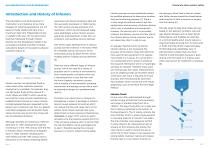
Passionate about patient safety. Introduction and History of Infusion The prescription and administration of medication is an imprecise art as many dosages, for instance paracetamol, are not based on body weight and have only a maximum daily limit independent of size or weight of the user. On the other hand, treatment delivered through infusion directly into the bloodstream needs to be accurately controlled and often includes calculations based on the patient’s physical condition (Figure 2). Figure 2 - Intravenous (IV) therapy Infusion pumps can administer fluids in cases where other...
Open the catalog to page 4
Passionate about patient safety. Types of Infusion There is a variety of different types of infusion devices which all have individual procedures and mechanisms. However, they share an aim to provide accurate infusion at a predetermined rate over a set period of time. Infusion pumps in general use positive pumping actions which provide an accurate flow of fluids or drugs and all infusion pumps have commonalities including the alarm systems and the control panel etc. Pumps are designed for a variety of clinical applications and their performance characteristics vary depending on the delivery...
Open the catalog to page 5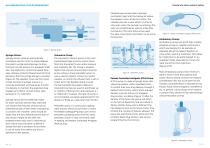
Passionate about patient safety. TO PATIENT CARRIAGE GUIDE MOTOR GEARBOX LEAD SCREW Cassette type pumps have a plunger mechanism built into the tubing set where the stepper motor drives the motion. The cassette also has a valve which is timed to only open when the plunger is pumping. This valve can sometimes be used as a free-flow mechanism. The Ivion Kids pumps used this type of pumping mechanism as do some PCA pumps. Figure 5 - Syringe pump Syringe Drivers Syringe drivers utilise an electronically controlled, electric motor to slowly depress the plastic syringe piston/plunger to drive the...
Open the catalog to page 6
Passionate about patient safety. Infusion Characteristics In an infusion system, the pump uses pressure to overcome the resistance to flow to deliver infusion. The greater the resistance in the IV circuit the higher the pressure is required to deliver the prescribed flow. Resistance arises due to filters, anti-siphon and anti-reflux valves, administration set, in particular the cannula, the internal diameter and potential kinking of tubing. This along with sticky (viscous) solutions and syringe/ cassette stiction can accumulate the pressure [7]. The pressure available is related to the...
Open the catalog to page 7
Passionate about patient safety. Problems Associated with Infusion Millions of infusion devices are used in hospitals and in the community every year. The vast majority of infusions are delivered safely. However, incidents with infusion devices continue to dominate adverse incident reports with at least 1000 incidents investigated by the MHRA between 2005 and 2010 in the UK alone [4, 10] and in the USA over 700 deaths were thought to be linked to problems with the device in the last five years [2]. The majority of problems relate to overinfusion of drugs, either due to user error with...
Open the catalog to page 8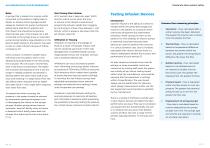
Passionate about patient safety. AN INTRODUCTION TO ELECTROSURGERY Bolus A syringe that is placed into a pump whilst connected to the patient is highly likely to deliver an infusion bolus. Syringes should always be inserted into pump mechanisms before being attached to patients and the infusion line should be temporarily disconnected. Even if the infusion set is left connected to the syringe driver or volumetric pump during transfers, large alterations in the device height relative to the patient may lead to over or under-infusion because of tubing compliance [7]. Once occlusion is cleared...
Open the catalog to page 9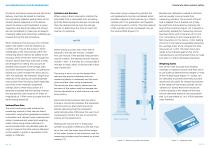
Passionate about patient safety. Occlusion and alarm pressures and also bolus delivery must also be tested to maintain the Innovating Together performance of the infusion device especially in PCA devices where the bolus is self-medicated. A visual inspection and electrical safety test should also be considered to make sure all aspects of patient safety and instrument reliability are covered during the test procedure. When looking at the accuracy of an infusion system the system must be looked at as a whole, and not just the pump or driver individually as the inaccuracies within the...
Open the catalog to page 10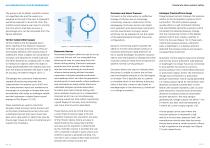
Passionate about patient safety. The pump is set to deliver a specific volume at a specified rate and the vessel is reweighed at the end of the test. A stopwatch would be required to record the time. This method would require user input to monitor the time and to maintain accuracy. A percentage error can be calculated from the figures obtained. Vernier Calipers/Dial Gauges Vernier calipers and dial gauges give a direct reading of the distance measured with high accuracy and precision. They are functionally identical, with varying ways of reading the result. Calipers are comprised of two...
Open the catalog to page 11All RIGEL Medical catalogs and technical brochures
-
SafeTest 60
3 Pages
-
CITREX H3
1 Pages
-
SafeTest 99
3 Pages
-
FlowAnalyser PRO
4 Pages
-
CITREX H5
2 Pages
-
Guide to Electrosurgery
19 Pages
-
IEC 62353
29 Pages
-
IEC 60601
18 Pages
-
Global Brochure
17 Pages
-
CITREX
6 Pages
-
PRODUCT RANGE 2018
12 Pages
-
Med-eBase
2 Pages
-
PRODUCT RANGE 2017
12 Pages
-
UniPulse 400
2 Pages
-
Printers and Scanners
6 Pages
-
Rigel 62353+
5 Pages
-
VenTest 800 Series
8 Pages
-
Rigel 288+
5 Pages
-
PULS-R
2 Pages
Archived catalogs
-
PatSim200
2 Pages
-
Rigel Multi-Flo Datasheet
6 Pages
-
Uni-Pulse
6 Pages
-
M e d - e B a s e v 2 . 0
3 Pages
-
RIGEL
20 Pages
-
SP-SIM SpO2 Simulator
5 Pages
-
BP-SiM NIBP Simulator
5 Pages
-
Rigel Medical Brochure - USA
20 Pages
-
Rigel Medical Brochure UK
20 Pages


































